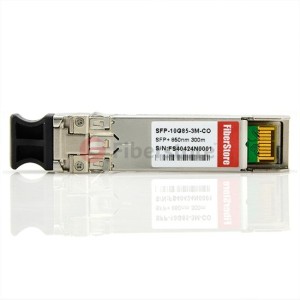Now fiber optic transceivers are commercially available for almost all international and industrial standards, including Ethernet, Fast Ethernet, Gigabit Ethernet, 10Gbit Ethernet. What’s take an important role in this situation is SFP fiber optic transceiver. So let’s take an eye on it. SFP is also called small form-factor pluggable which is a version of Mini GBIC. at first sight, you can find the size is only half of GBIC. It supports data rates up to 10 G. The SFP Transceiver are available with a variety of transmitter and receiver types. What’s more, it is with LC interface. The kind of SFP transceiver module called SFP-10G-SR in Fiberstore is a quite well choice, it is nearly same as Cisco SFP 10G SR. SFP is regarded as a hot pluggable module, this make it Effortless to alter and effortless for upkeep in comparison with conventional modules. It makes the Ethernet network easier to upgrade and sustain. End users can replace a Solitary SFP module Throughout the Procedure Rather of replace the complete board with various modules on it.
SFP+ twinax cables are copper cables with two SFP+ transceivers attached on either end. This SFP cable is also known as Direct Attach Cables (DAC). Using twinax cable is significantly cheaper than connecting devices using two 10 Gbps fiber optic transceivers over fiber cable. There are two types of twinax cables. active and passive. In IBM b-type switches only active cables are supported which contain Vital Product Data (VPD) information. Twinax cable is available in length of 1m, 3m, and 5m. Also referred to as twinax, a direct-attach twinaxial cable is very similar to coaxial cable, except for one additional copper conductor core. Both twinax cores are protected by an insulator layer and another metallic conductor surrounding the core pair. Analogous to twisted-pair cables, both cores are twirled together to diminish interference effects from outside sources.
Originally created by IBM for shorter-distance connections, twinax cables offer a cost effective way to interconnect Ethernet devices within racks and across adjacent racks. These cables are usually accommodated into the transceiver housing of a switch or server. Direct-attach 10 Gigabit Ethernet twinax cables have Enhanced small form factor pluggable (SFP+) compatible connectors while 40 Gigabit Ethernet twinax cables deploy Enhanced Quad small form factor pluggable (QSFP+) connectors.
On both data rates, twinax cables are available in the following types. Active: Have components in the SFP+ or QSFP+ housing to improve the signal quality. Usually covers 7 and 10 meters. Passive: Have straight conduction between devices and are available in 1, 3, and 5 meters. for example Cisco SFP-H10GB-CU1M and what SFP-H10GB-CU1M in Fiberstore has same functions with Cisco’s and it also fully compatible with Cisco devices, the same time the price is lower than Cisco’s. Twinax cables have achieved high popularity in data centers because of their high benefit/cost ratio. As an additional advantages, twinax cables present a much lower bit error rate (1 error in 10 E18 bits transmitted) than the IEEE requirements for 10 Gigabit Ethernet connections (1 error in 10E12 bits transmitted). Although the 2004 IEEE 802.3ak standard was the first to introduce 10 Gigabit Ethernet in Twinax cables (10 GBase-CX4), this superseded solution was based on infiniband twinax cables, The twinax cables currently used in 10 Gigabit Ethernet are standardized by the small form format committee standard SFF-8431 and 8461.
Although the Ethernet standardization process has its fair share of politics, the study of its timeline remains a good way to access the networking industry trends over the last three decades. we can see some trends, such as twisted-pair roughly increased ten times its data rate every five years. That pace, however, did not continue in speeds higher than 10 Gbps. Optical fiber had a slightly faster development, being the first media to support data rates higher than 100 Mbps. It also presented the highest longevity among all media. Twinax cables have risen as a viable Ethernet option for 10-Gbps connections.
Because of the higher cost of optical transceivers, fiber is typically employed on links between switches, where higher speeds are required the earliest. High-volume connections, such as server access, depend on lower costs to justify an upgrade to faster data rates. For that reason, twisted-pair and direct-attach twinax cables have been the most popular choices for these connections.
At last, The above information are come from Fiberstore fiber optic manufacturer. Go ahead to check out the details! And the same time there is a good news is that Fiberstore is making a 30% discount about most products, welcome you to visit our online store.

